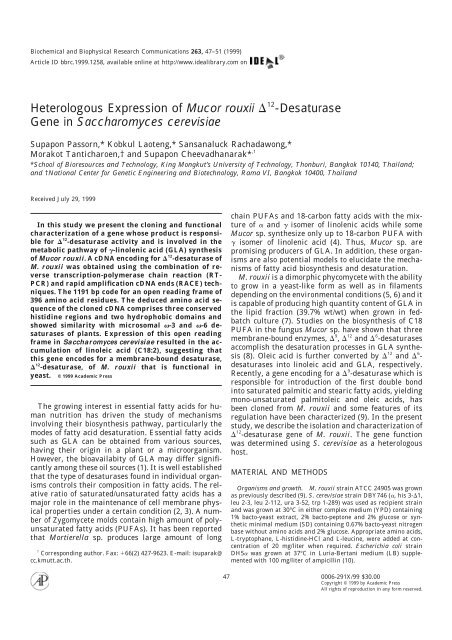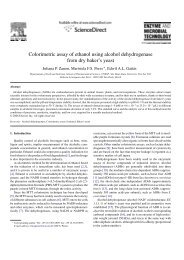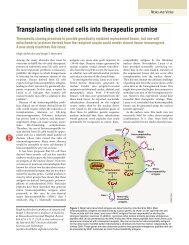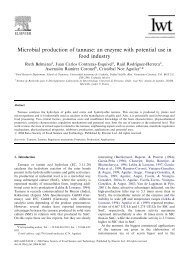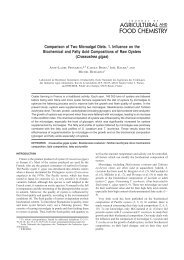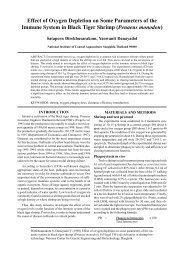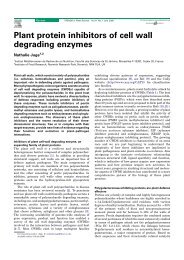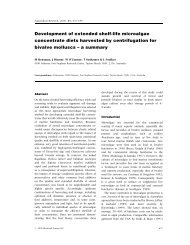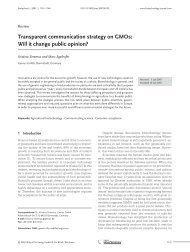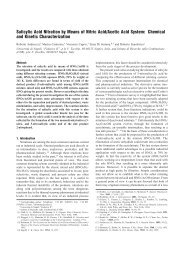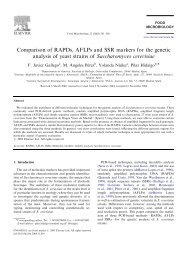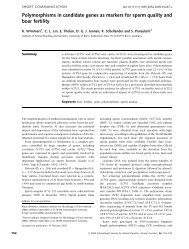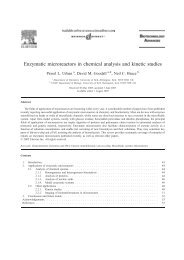Heterologous Expression of Mucor rouxii Δ12-Desaturase Gene in ...
Heterologous Expression of Mucor rouxii Δ12-Desaturase Gene in ...
Heterologous Expression of Mucor rouxii Δ12-Desaturase Gene in ...
You also want an ePaper? Increase the reach of your titles
YUMPU automatically turns print PDFs into web optimized ePapers that Google loves.
Biochemical and Biophysical Research Communications 263, 47–51 (1999)<br />
Article ID bbrc.1999.1258, available onl<strong>in</strong>e at http://www.idealibrary.com on<br />
<strong>Heterologous</strong> <strong>Expression</strong> <strong>of</strong> <strong>Mucor</strong> <strong>rouxii</strong> � 12 -<strong>Desaturase</strong><br />
<strong>Gene</strong> <strong>in</strong> Saccharomyces cerevisiae<br />
Supapon Passorn,* Kobkul Laoteng,* Sansanaluck Rachadawong,*<br />
Morakot Tanticharoen,† and Supapon Cheevadhanarak* ,1<br />
*School <strong>of</strong> Bioresources and Technology, K<strong>in</strong>g Mongkut’s University <strong>of</strong> Technology, Thonburi, Bangkok 10140, Thailand;<br />
and †National Center for <strong>Gene</strong>tic Eng<strong>in</strong>eer<strong>in</strong>g and Biotechnology, Rama VI, Bangkok 10400, Thailand<br />
Received July 29, 1999<br />
In this study we present the clon<strong>in</strong>g and functional<br />
characterization <strong>of</strong> a gene whose product is responsible<br />
for � 12 -desaturase activity and is <strong>in</strong>volved <strong>in</strong> the<br />
metabolic pathway <strong>of</strong> �-l<strong>in</strong>olenic acid (GLA) synthesis<br />
<strong>of</strong> <strong>Mucor</strong> <strong>rouxii</strong>. A cDNA encod<strong>in</strong>g for � 12 -desaturase <strong>of</strong><br />
M. <strong>rouxii</strong> was obta<strong>in</strong>ed us<strong>in</strong>g the comb<strong>in</strong>ation <strong>of</strong> reverse<br />
transcription-polymerase cha<strong>in</strong> reaction (RT-<br />
PCR) and rapid amplification cDNA ends (RACE) techniques.<br />
The 1191 bp code for an open read<strong>in</strong>g frame <strong>of</strong><br />
396 am<strong>in</strong>o acid residues. The deduced am<strong>in</strong>o acid sequence<br />
<strong>of</strong> the cloned cDNA comprises three conserved<br />
histid<strong>in</strong>e regions and two hydrophobic doma<strong>in</strong>s and<br />
showed similarity with microsomal �-3 and �-6 desaturases<br />
<strong>of</strong> plants. <strong>Expression</strong> <strong>of</strong> this open read<strong>in</strong>g<br />
frame <strong>in</strong> Saccharomyces cerevisiae resulted <strong>in</strong> the accumulation<br />
<strong>of</strong> l<strong>in</strong>oleic acid (C18:2), suggest<strong>in</strong>g that<br />
this gene encodes for a membrane-bound desaturase,<br />
� 12 -desaturase, <strong>of</strong> M. <strong>rouxii</strong> that is functional <strong>in</strong><br />
yeast. © 1999 Academic Press<br />
The grow<strong>in</strong>g <strong>in</strong>terest <strong>in</strong> essential fatty acids for human<br />
nutrition has driven the study <strong>of</strong> mechanisms<br />
<strong>in</strong>volv<strong>in</strong>g their biosynthesis pathway, particularly the<br />
modes <strong>of</strong> fatty acid desaturation. Essential fatty acids<br />
such as GLA can be obta<strong>in</strong>ed from various sources,<br />
hav<strong>in</strong>g their orig<strong>in</strong> <strong>in</strong> a plant or a microorganism.<br />
However, the bioavailabity <strong>of</strong> GLA may differ significantly<br />
among these oil sources (1). It is well established<br />
that the type <strong>of</strong> desaturases found <strong>in</strong> <strong>in</strong>dividual organisms<br />
controls their composition <strong>in</strong> fatty acids. The relative<br />
ratio <strong>of</strong> saturated/unsaturated fatty acids has a<br />
major role <strong>in</strong> the ma<strong>in</strong>tenance <strong>of</strong> cell membrane physical<br />
properties under a certa<strong>in</strong> condition (2, 3). A number<br />
<strong>of</strong> Zygomycete molds conta<strong>in</strong> high amount <strong>of</strong> polyunsaturated<br />
fatty acids (PUFAs). It has been reported<br />
that Mortierella sp. produces large amount <strong>of</strong> long<br />
1<br />
Correspond<strong>in</strong>g author. Fax: �66(2) 427-9623. E-mail: isuparak@<br />
cc.kmutt.ac.th.<br />
cha<strong>in</strong> PUFAs and 18-carbon fatty acids with the mixture<br />
<strong>of</strong> � and � isomer <strong>of</strong> l<strong>in</strong>olenic acids while some<br />
<strong>Mucor</strong> sp. synthesize only up to 18-carbon PUFA with<br />
� isomer <strong>of</strong> l<strong>in</strong>olenic acid (4). Thus, <strong>Mucor</strong> sp. are<br />
promis<strong>in</strong>g producers <strong>of</strong> GLA. In addition, these organisms<br />
are also potential models to elucidate the mechanisms<br />
<strong>of</strong> fatty acid biosynthesis and desaturation.<br />
M. <strong>rouxii</strong> is a dimorphic phycomycete with the ability<br />
to grow <strong>in</strong> a yeast-like form as well as <strong>in</strong> filaments<br />
depend<strong>in</strong>g on the environmental conditions (5, 6) and it<br />
is capable <strong>of</strong> produc<strong>in</strong>g high quantity content <strong>of</strong> GLA <strong>in</strong><br />
the lipid fraction (39.7% wt/wt) when grown <strong>in</strong> fedbatch<br />
culture (7). Studies on the biosynthesis <strong>of</strong> C18<br />
PUFA <strong>in</strong> the fungus <strong>Mucor</strong> sp. have shown that three<br />
membrane-bound enzymes, � 9 , � 12 and � 6 -desaturases<br />
accomplish the desaturation processes <strong>in</strong> GLA synthesis<br />
(8). Oleic acid is further converted by � 12 and � 6 -<br />
desaturases <strong>in</strong>to l<strong>in</strong>oleic acid and GLA, respectively.<br />
Recently, a gene encod<strong>in</strong>g for a � 9 -desaturase which is<br />
responsible for <strong>in</strong>troduction <strong>of</strong> the first double bond<br />
<strong>in</strong>to saturated palmitic and stearic fatty acids, yield<strong>in</strong>g<br />
mono-unsaturated palmitoleic and oleic acids, has<br />
been cloned from M. <strong>rouxii</strong> and some features <strong>of</strong> its<br />
regulation have been characterized (9). In the present<br />
study, we describe the isolation and characterization <strong>of</strong><br />
� 12 -desaturase gene <strong>of</strong> M. <strong>rouxii</strong>. The gene function<br />
was determ<strong>in</strong>ed us<strong>in</strong>g S. cerevisiae as a heterologous<br />
host.<br />
MATERIAL AND METHODS<br />
Organisms and growth. M. <strong>rouxii</strong> stra<strong>in</strong> ATCC 24905 was grown<br />
as previously described (9). S. cerevisiae stra<strong>in</strong> DBY746 (�, his 3-�1,<br />
leu 2-3, leu 2-112, ura 3-52, trp 1-289) was used as recipient stra<strong>in</strong><br />
and was grown at 30°C <strong>in</strong> either complex medium (YPD) conta<strong>in</strong><strong>in</strong>g<br />
1% bacto-yeast extract, 2% bacto-peptone and 2% glucose or synthetic<br />
m<strong>in</strong>imal medium (SD) conta<strong>in</strong><strong>in</strong>g 0.67% bacto-yeast nitrogen<br />
base without am<strong>in</strong>o acids and 2% glucose. Appropriate am<strong>in</strong>o acids,<br />
L-tryptophane, L-histid<strong>in</strong>e-HCl and L-leuc<strong>in</strong>e, were added at concentration<br />
<strong>of</strong> 20 mg/liter when required. Escherichia coli stra<strong>in</strong><br />
DH5� was grown at 37°C <strong>in</strong> Luria-Bertani medium (LB) supplemented<br />
with 100 mg/liter <strong>of</strong> ampicill<strong>in</strong> (10).<br />
47 0006-291X/99 $30.00<br />
Copyright © 1999 by Academic Press<br />
All rights <strong>of</strong> reproduction <strong>in</strong> any form reserved.
Vol. 263, No. 1, 1999 BIOCHEMICAL AND BIOPHYSICAL RESEARCH COMMUNICATIONS<br />
FIG. 1. Comparison <strong>of</strong> deduced am<strong>in</strong>o acids <strong>of</strong> � 12 -desaturase cDNA <strong>of</strong> M. <strong>rouxii</strong> (<strong>Mucor</strong>-�6), �-3 desaturase <strong>of</strong> A. thaliana (Arabid-�6),<br />
B. napus (Brassi-�3), and � 12 -desaturase <strong>of</strong> Synechosistis (Synecho-�6). Black backgrounds <strong>in</strong>dicate identity <strong>of</strong> am<strong>in</strong>o acid residues. The<br />
three conserved histid<strong>in</strong>e motifs are <strong>in</strong>dicated by bars.<br />
DNA manipulations. All recomb<strong>in</strong>ant DNA procedures were done<br />
accord<strong>in</strong>g to standard methods (10). DNA sequenc<strong>in</strong>g was performed by<br />
the dideoxy cha<strong>in</strong> term<strong>in</strong>ation method (11) us<strong>in</strong>g T7 Sequenase, version<br />
2.0 DNA sequenc<strong>in</strong>g kit (Amersham, Buck<strong>in</strong>ghamshire, UK). Restriction<br />
enzymes were from Boher<strong>in</strong>ger Mannheim (Mannheim, Germany).<br />
Clon<strong>in</strong>g <strong>of</strong> � 12 -desaturase cDNA from M. <strong>rouxii</strong>. Reverse<br />
transcription-polymerase cha<strong>in</strong> reaction (RT-PCR) was used for partial<br />
� 12 -desaturase cDNA amplification. Mycelia <strong>of</strong> M. <strong>rouxii</strong> were<br />
harvested and used for RNA preparation as previously described (9).<br />
Total RNA was reverse transcribed <strong>in</strong>to first-strand cDNA us<strong>in</strong>g<br />
oligo(dT) 17 primer and SuperScript II RNase H � from GIBCO BRL<br />
(Paisley, UK). The first-strand cDNA was used as template for PCR<br />
us<strong>in</strong>g degenerated primers, 5�-GCGAATTC(A/G)TIGGTCA(T/C)-<br />
GA(T/C)TG(T/C)GGICA-3� (forward) and 5�-GCGAATTCATIT(G/<br />
T)IGG(A/G)AAIA(A/G)(A/G)TG(A/G)TG-3� (reverse), which conta<strong>in</strong><br />
<strong>in</strong>os<strong>in</strong>e (stand by I) and an EcoRI site (underl<strong>in</strong>e) at 5� end to<br />
facilitate subsequent manipulation. These primers were designed on<br />
the conserved histid<strong>in</strong>e boxes <strong>of</strong> microsomal �-3 desaturase genes <strong>of</strong><br />
Glyc<strong>in</strong>e max (12), Arabidopsis thaliana (13), Brassica napus (12),<br />
correspond<strong>in</strong>g to the am<strong>in</strong>o acid sequences GHDCGH and HHLFP,<br />
48<br />
respectively. Nucleotide sequences <strong>of</strong> 5� and 3� ends <strong>of</strong> the � 12 -<br />
desaturase cDNA were amplified by the method <strong>of</strong> rapid amplification<br />
<strong>of</strong> cDNA ends (RACE). 5� RACE System (GIBCO BRL, Paisley,<br />
UK) was used for amplification <strong>of</strong> the 5� cDNA, follow<strong>in</strong>g by the<br />
manufacturers’ <strong>in</strong>struction and us<strong>in</strong>g the gene specific primers<br />
(GSP), 5�-GAAGTAGTCGAGGAGGAAGC-3� and 5�-TGATAGTC-<br />
TTTGAAGGGCTG-3�, designed from the nucleotide sequences <strong>of</strong><br />
RT-PCR DNA fragment. Amplification <strong>of</strong> 3� end was performed by<br />
method <strong>of</strong> 3� RACE as described by Innis et al. (14). The primers for<br />
3� RACE were oligo(dT) 17 adapter primer (for first strand cDNA<br />
synthesis), a 5�-CTGTTGATCGTTCTTATGGC-3� (forward primer)<br />
and an adapter primer 5�-GAGGACTCGAGCTCAAGC-3� (reverse<br />
primer). All PCR fragments were subcloned <strong>in</strong>to pGEM-T easy vector<br />
(Promaga, Madison, WI) and transformed <strong>in</strong>to E. coli. Subsequently,<br />
nucleotide sequences were determ<strong>in</strong>ed. Analysis <strong>of</strong> the sequences<br />
was done with GENETYXE-WIN Version 3.1. The sequence <strong>of</strong> � 12 -<br />
desaturase cDNA has been deposited <strong>in</strong> GenBank database and<br />
assigned the Accession No. AF161219.<br />
Plasmid construction and yeast transformation. The complete<br />
� 12 -desaturase cDNA from M. <strong>rouxii</strong> was amplified by RT-PCR us<strong>in</strong>g
Vol. 263, No. 1, 1999 BIOCHEMICAL AND BIOPHYSICAL RESEARCH COMMUNICATIONS<br />
FIG. 2. Hydropathy plot <strong>of</strong> � 12 -desaturase <strong>of</strong> M. <strong>rouxii</strong> (A), A.<br />
thaliana (B), and Synechocystis sp PCC6714 (C). Hydropathy pr<strong>of</strong>iles<br />
were analyzed us<strong>in</strong>g a Kyte–Doolittle scale (31). Numbers on the<br />
x-axis are am<strong>in</strong>o acid residues. Two hydrophobic doma<strong>in</strong>s are <strong>in</strong>dicated<br />
by bars.<br />
two specific primers, 5�-CGCGGATCCATGGCAACCAAGAGAA-<br />
ACG-3� and 5�-GCCGAATTCTTAGTTCTTAAAGAAGAC-3� which<br />
correspond to the nucleotide sequences <strong>of</strong> start and stop codons (<strong>in</strong><br />
boldface) <strong>of</strong> the � 12 -desaturase cod<strong>in</strong>g region, respectively. The 5� end<br />
<strong>of</strong> both primers conta<strong>in</strong><strong>in</strong>g a BamHI and EcoRI sites, respectively,<br />
were underl<strong>in</strong>ed to facilitate subsequent manipulation. The amplified<br />
cDNA was digested and subcloned <strong>in</strong>to BamHI-EcoRI site <strong>of</strong> the<br />
expression vector pYES2 (Invitrogen, Netherlands) to generate a<br />
plasmid designated pYCD12. S. cerevisiae was transformed with<br />
pYCD12 and pYES2 us<strong>in</strong>g alkali cation yeast transformation kit<br />
(BIO 101, Vista, CA) accord<strong>in</strong>g to manufacturer’s <strong>in</strong>struction. Transformants<br />
were selected by plat<strong>in</strong>g on SD agar lack<strong>in</strong>g uracil and<br />
grown at 30°C for 3–4 days.<br />
Induction <strong>of</strong> � 12 -desaturase gene expression and fatty acid analysis.<br />
<strong>Expression</strong> <strong>of</strong> M. <strong>rouxii</strong> � 12 -desaturase gene was <strong>in</strong>duced under transcriptional<br />
control <strong>of</strong> the yeast GAL1 promoter. Yeast cultures were<br />
grown to logarithmic phase at 30°C with aeration <strong>in</strong> YPG medium.<br />
Subsequently, cells were recovered by centrifugation followed by<br />
wash<strong>in</strong>g the cells <strong>in</strong> sterile sal<strong>in</strong>e prior to transferr<strong>in</strong>g <strong>in</strong>to SD<br />
medium conta<strong>in</strong><strong>in</strong>g 2% galactose to <strong>in</strong>duce GAL1 promoter activity<br />
(15). Cultures were then grown aerobically to saturation for further<br />
24 h, subsequently cells were harvested by centrifugation and<br />
washed by sterile distilled water. Cell pellets were lyophilized and<br />
used for determ<strong>in</strong>ation <strong>of</strong> fatty acid composition by gas chromatography<br />
(GC) as previously described (9).<br />
RESULTS AND DISCUSSION<br />
L<strong>in</strong>oleic acid is classified to an essential fatty acid<br />
group for human s<strong>in</strong>ce mammals lack the gene cod<strong>in</strong>g<br />
for � 12 -desaturase enzyme (4, 16). A partial � 12 -<br />
desaturase cDNA <strong>of</strong> M. <strong>rouxii</strong> was cloned by RT-PCR<br />
us<strong>in</strong>g degenerated primers which were designed based<br />
on the presence <strong>of</strong> histid<strong>in</strong>e residue motifs characteristic<br />
<strong>of</strong> membrane-bound desaturases (12, 13, 17, 18,<br />
49<br />
19). A DNA fragment approximately 700 bp long amplified<br />
by RT-PCR showed am<strong>in</strong>o acid sequences similar<br />
to the �-6 and �-3 desaturase genes <strong>of</strong> other organisms<br />
(12, 13, 20, 21). To clone the full length � 12 -<br />
desaturase cDNA, 5� and 3� ends <strong>of</strong> the gene were<br />
amplified by RACE method. 385 bp <strong>of</strong> 5� RACE and 365<br />
bp <strong>of</strong> 3� RACE were obta<strong>in</strong>ed and sequences determ<strong>in</strong>ed.<br />
The nucleotide sequences <strong>of</strong> both products from<br />
RACE experiments share an identical sequence overlap<br />
on flank<strong>in</strong>g regions <strong>of</strong> 5� and 3� end <strong>of</strong> RT-PCR DNA<br />
fragment suggest<strong>in</strong>g that these fragments are portions<br />
<strong>of</strong> the same gene. The full length cDNA conta<strong>in</strong>s an<br />
open read<strong>in</strong>g frame (ORF) <strong>of</strong> 1,911 bp encod<strong>in</strong>g for 396<br />
am<strong>in</strong>o acid residues with an estimated molecular mass<br />
<strong>of</strong> 45 kDa. The ORF <strong>of</strong> this gene exhibits am<strong>in</strong>o acid<br />
sequence homology with other desaturases (Fig. 1). It<br />
shows 34% identity (62% similarity) with microsomal<br />
�-6 desaturase <strong>of</strong> Arabidopsis thaliana (22) 31% identity<br />
(58% similarity) with microsomal �-3 desaturase <strong>of</strong><br />
B. napus (12) and 16% identity (42% similarity) with<br />
desA <strong>of</strong> Synechocystis (23). This result reveals that the<br />
ORF has more homology with �-6 desaturase than �-3<br />
desaturase <strong>of</strong> plants although we designed primers for<br />
the RT-PCR based on plant �-3 desaturases. Nevertheless,<br />
it also shares common characteristics to known<br />
membrane-bound desaturases (9, 12, 13, 17, 18, 23). M.<br />
<strong>rouxii</strong> ORF comprises three histid<strong>in</strong>e-cluster motifs<br />
that are conserved <strong>in</strong> other membrane-bound desaturases.<br />
Moreover, the hydropathy pr<strong>of</strong>ile <strong>of</strong> am<strong>in</strong>o acid<br />
sequences <strong>of</strong> this prote<strong>in</strong> shows two hydrophobic doma<strong>in</strong>s<br />
similar to plant and cyanobacteria � 12 -<br />
desaturases (22, 23) which have membrane spann<strong>in</strong>g<br />
FIG. 3. Gas chromatograms <strong>of</strong> total fatty acid from the <strong>in</strong>duced<br />
yeast cells conta<strong>in</strong><strong>in</strong>g pYES2 (A) and pYCD12 (B). Peaks 1, C16:0; 2,<br />
C16:1(�-9); 3, C17:0 (<strong>in</strong>ternal standard); 4, C18:0; 5, C18:1(�-9); 6,<br />
C18:2 (�-9,12).
Vol. 263, No. 1, 1999 BIOCHEMICAL AND BIOPHYSICAL RESEARCH COMMUNICATIONS<br />
TABLE 1<br />
Fatty Acid Composition <strong>of</strong> Total Lipid from Yeast<br />
Transformants Conta<strong>in</strong><strong>in</strong>g pYES2 and pYCD12<br />
Transformants<br />
Relation fatty acid composition (mol %)<br />
C16:0 C16:1 C18:0 C18:1 C18:2<br />
pYES2 21.6 46.2 5.6 26.6 —<br />
pYCD12 23.6 37.6 6.9 8.8 22.7<br />
Note. Values represent the averages <strong>of</strong> three <strong>in</strong>dependent transformants.<br />
The fatty acid composition <strong>of</strong> each sample was analyzed<br />
twice.<br />
doma<strong>in</strong>s (Fig. 2). Each conserved histid<strong>in</strong>e-region is<br />
located <strong>in</strong> the hydrophilic portion that may be located<br />
on the cytoplasmic surface <strong>of</strong> the membrane. These<br />
features co<strong>in</strong>cide with a model <strong>of</strong> the topology <strong>of</strong><br />
membrane-bound desaturases (24). More recently, a<br />
� 12 -desaturase gene has been cloned from a fungus,<br />
Mortierella alp<strong>in</strong>a (25). We found that the gene <strong>of</strong> M.<br />
<strong>rouxii</strong> also has high homology with the � 12 -desaturase<br />
<strong>of</strong> M. alp<strong>in</strong>a. Therefore, we propose that this gene<br />
encodes for a putative � 12 -desaturase <strong>of</strong> M. <strong>rouxii</strong>.<br />
Jackson et al. have reported that the � 12 -desaturase <strong>of</strong><br />
the fungus <strong>Mucor</strong> circ<strong>in</strong>elloides <strong>in</strong>troduces double<br />
bonds <strong>in</strong>to oleate which is esterifed to glycerolipid (8).<br />
The homology <strong>of</strong> M. <strong>rouxii</strong> � 12 -desaturase with enzymes<br />
from plant �-6 and �-3 desaturases and cyanobacteria<br />
� 12 -desaturase might support the hypothesis<br />
that the cloned gene belongs to a member <strong>of</strong> acyllipid<br />
desaturase group.<br />
Cytochrome b 5-doma<strong>in</strong>s have been discovered <strong>in</strong> either<br />
the C- or N-term<strong>in</strong>us <strong>of</strong> several membrane-bound<br />
desaturases such as � 9 -desaturase <strong>of</strong> S. cerevisiae (26)<br />
and M. <strong>rouxii</strong> (9), � 6 -desaturase <strong>of</strong> Borago <strong>of</strong>fic<strong>in</strong>alis<br />
(17), Caenorhabditis elegans (27) and rat (28) and<br />
sph<strong>in</strong>golipid desaturase <strong>of</strong> A. thaliana (29). However,<br />
this doma<strong>in</strong> is absent <strong>in</strong> the � 12 -desaturase gene <strong>of</strong> M.<br />
<strong>rouxii</strong> as well as <strong>in</strong> � 12 -desaturase <strong>of</strong> plant and M.<br />
alp<strong>in</strong>a (25). Nevertheless, it has been reported that<br />
cytochrome b 5 is required as an electron donor for the<br />
desaturation <strong>in</strong> microsomal membranes <strong>of</strong> fungi (8).<br />
To study the function <strong>of</strong> the putative � 12 -desaturase<br />
gene <strong>of</strong> M. <strong>rouxii</strong>, the 396 am<strong>in</strong>o acids <strong>of</strong> cod<strong>in</strong>g region<br />
were amplified and subcloned <strong>in</strong>to the yeast expression<br />
vector, pYES2, downstream <strong>of</strong> the galactose <strong>in</strong>ducible<br />
GAL1 promotor. Control (pYES2) and recomb<strong>in</strong>ant<br />
(pYCD12) plasmids were <strong>in</strong>troduced <strong>in</strong>to yeast and the<br />
expression was <strong>in</strong>duced by the addition <strong>of</strong> 2% galactose.<br />
Fatty acid compositions <strong>of</strong> the cultures transformed<br />
with pYES2 and pYCD12 were analyzed as<br />
shown <strong>in</strong> Fig. 3 and Table 1. The GC analysis revealed<br />
that a novel dienoic fatty acid (C18:2, �-9,12) was<br />
found <strong>in</strong> pYCD12 transformants (22.6% <strong>in</strong> total lipid)<br />
but could not be detected <strong>in</strong> the control. The reduced<br />
amount <strong>of</strong> oleic acid <strong>in</strong> pYCD12 transformants was<br />
50<br />
caused by the conversion <strong>of</strong> oleic <strong>in</strong>to l<strong>in</strong>oleic acid.<br />
Thus, the accumulation <strong>of</strong> l<strong>in</strong>oleic acid <strong>in</strong> the transformed<br />
yeast <strong>in</strong>dicates that the M. <strong>rouxii</strong> cDNA encodes<br />
for a prote<strong>in</strong> with � 12 -desaturase activity. This<br />
function was accomplished <strong>in</strong> yeast us<strong>in</strong>g its component<br />
<strong>of</strong> redox system, NADH-dependent cytochrome b 5<br />
reductase and cytochrome b 5.<br />
The regulation <strong>of</strong> genes <strong>in</strong>volved <strong>in</strong> desaturation pathway<br />
has been <strong>in</strong>vestigated <strong>in</strong> various organisms. The<br />
expression <strong>of</strong> fatty acid desaturase genes depends on<br />
several factors such as age <strong>of</strong> culture, species and <strong>in</strong>teract<strong>in</strong>g<br />
environment (2, 9, 30, 31). We found that expression<br />
<strong>of</strong> M. <strong>rouxii</strong> � 9 -desaturase gene was affected by low<br />
temperature and cell growth (9). It would be <strong>of</strong> <strong>in</strong>terest to<br />
determ<strong>in</strong>e whether the regulation <strong>of</strong> gene expression <strong>of</strong><br />
� 12 -desaturase relates to that <strong>of</strong> � 9 -desaturase gene <strong>in</strong> M.<br />
<strong>rouxii</strong>. In conclusion, we have identified and functionally<br />
characterized the � 12 -desaturase gene encod<strong>in</strong>g an enzyme<br />
<strong>in</strong> GLA synthesis pathway <strong>of</strong> M. <strong>rouxii</strong>.<br />
ACKNOWLEDGMENTS<br />
This work was supported by a grant from National Center for<br />
<strong>Gene</strong>tic Eng<strong>in</strong>eer<strong>in</strong>g and Biotechnology (BIOTEC), Thailand. We<br />
thank Dr. Bruno Maresca (IIGB, Italy) for his critical comments and<br />
for carefully read<strong>in</strong>g the manuscript. Kobkul Laoteng was supported<br />
by a fellowship by GREC <strong>of</strong> the National Science and Technology<br />
Development Agency (NSTDA), Thailand.<br />
REFERENCES<br />
1. Jenk<strong>in</strong>s, D. K., Mitchell, J., Manku, M. S., and Horrob<strong>in</strong>, D. F.<br />
(1988) Med. Sci. Res. 16, 525–526.<br />
2. Macartney, A., Maresca, B., and Coss<strong>in</strong>s, A. R. (1994) <strong>in</strong> Tempereature<br />
Adaptation <strong>of</strong> Biological Membranes (Coss<strong>in</strong>s, A. R.,<br />
Ed.), pp. 63–76, Portland Press, London.<br />
3. Vigh, L., Maresca, B., and Harwood, J. L. (1998) Trends Biochem.<br />
Sc. 23, 369–374.<br />
4. Phillips, J. C., and Huang, Y-S. (1996) <strong>in</strong> �-L<strong>in</strong>olenic Acid Metabolism<br />
and Its Roles <strong>in</strong> Nutrition and Medic<strong>in</strong>e (Huang, Y-S.,<br />
and Mills, D. E., Eds.), pp. 1–13, AOCS Press, Ill<strong>in</strong>ois.<br />
5. Haidle, C. W., and Storck, R. (1966) J. Bacteriol. 92, 1236–1244.<br />
6. Elmer, G. W., and Nickerson, W. J. (1970) J. Bacteriol. 101,<br />
595–602.<br />
7. Hansson, L., Dostalek, M., and Sorenby, B. (1989) Appl. Microbiol.<br />
Biotechnol. 31, 223–227.<br />
8. Jackson, F. M., Fraser, T. C. M., Smith, M. A., Lazarus, C.,<br />
Stobart, A. K., and Griffiths, G. (1998) Eur. J. Biochem. 252,<br />
513–519.<br />
9. Laoteng, K., Anjard, C., Rachadawong, S., Tanticharoen, M.,<br />
Maresca, B., and Cheevadhanarak, S. (1999) Mol. Cell Biol. Res.<br />
Commun. 1, 36–43.<br />
10. Sambrook, J., Fritsch, E. F., and Manitis, T. (1989) Molecular<br />
Clon<strong>in</strong>g: A Laboratory Manual, 2nd ed., Cold Spr<strong>in</strong>g Harbor<br />
Laboratory Press, Cold Spr<strong>in</strong>g Harbor, NY.<br />
11. Sanger, F., Nicklen, S., and Coulson, A. R. (1977) Proc. Natl.<br />
Acad. Sci. USA 74, 5463–5467.<br />
12. Yadav, N. S., Wierzbicki, A., Aegerter, M., Caster, C. S., Perez-<br />
Grau, L., K<strong>in</strong>ney, A. J., Hitz, W. D., Booth, J. R., Schweiger, B.,<br />
Stecca, K. L., Allen, S. M., Blackwell, M., Reiter, R. S., Carlson,
Vol. 263, No. 1, 1999 BIOCHEMICAL AND BIOPHYSICAL RESEARCH COMMUNICATIONS<br />
T. J., Russell, S. H., Feldman, K. A., Pierce, J., and Browse, J.<br />
(1993) Plant Physiol. 103, 466–476.<br />
13. Arondel, V., Lemieux, B., Hwang, I., Gibson, S., Goodman, H. M.,<br />
and Somerville, C. R. (1992) Science 258, 1353–1355.<br />
14. Innis, M. A., Gelfand, D. H., Sn<strong>in</strong>sky, J. J., and White, T. J. (1990)<br />
<strong>in</strong> PCR Protocols: A Guide to Methods and Applications (Frohman,<br />
M. A., Ed.), pp. 28–38. Academic Press, San Diego, CA.<br />
15. Clare, J. J., and Romanos, M. A. (1995) Methods Mol. Cell. Biol.<br />
5, 319–329.<br />
16. Certik, M., Sakuradani, E., and Shimizu, S. (1998) Trends Biotechnol.<br />
16, 500–505.<br />
17. Sayanova, O., Smith, M. A., Lap<strong>in</strong>skas, P., Stobart, A. K., Dobson,<br />
G., Christie, W. W., Shewry, P. R., and Napier, J. A. (1997)<br />
Proc. Natl. Acad. Sci. USA 94, 4211–4216.<br />
18. Michaelson, L. V., Lazarus, C., Griffiths, G., and Napier, J. A.<br />
(1998) J. Biol. Chem. 273, 19055–19059.<br />
19. Knutzon, S. D., Thurmond, J. M., Huang, Y-S., Chaudhary, S.,<br />
Bobik, E. G., Chan, G. M., Kirchner, S. J., and Mukerji, P. (1998)<br />
J. Biol. Chem. 273, 29360–29366.<br />
20. Heppard E. P., K<strong>in</strong>ney, A. J., Stecca, K. L., and Miao, G-H.<br />
(1996) Plant Physiol. 110, 311–319.<br />
21. Falcane, D. L., Gibson, S., Lemieux, B., and Somerville, C. (1994)<br />
Plant Physiol. 106, 1453–1459.<br />
51<br />
22. Okuley, J., Lightner, J., Feldmann, K. A., Yadav, N. S., Lark, E.,<br />
and Browse, J. (1994) Plant Cell 6, 147–158.<br />
23. Sakamoto, T., Wada, H., Nishida, I., Ohmori, M., and Murata, N.<br />
(1994) Plant Mol. Biol. 24, 643–650.<br />
24. Stukey, J. E., McDonough, V. M., and Mart<strong>in</strong>, C. E. (1990)<br />
J. Biol. Chem. 265, 20144–20149.<br />
25. Sakuradani, E., Kobayashi, M., Ashikari, T., and Shimizu, S.<br />
(1999) Eur. J. Biochem. 261, 812–820.<br />
26. Mitchell, A. G., and Mart<strong>in</strong>, C. E. (1995) J. Biol. Chem. 270,<br />
29766–29772.<br />
27. Napier, J. A., Hey, S. J., Lacey, D. J., and Shewry, P. R. (1998)<br />
Biochem. J. 330, 611–614.<br />
28. Aki, T., Shimada, Y., Inagaki, K., Higashimoto, H., Kawamoto,<br />
S., Shigete, S., Ono, K., and Suzuki, O. (1999) Biochem. Biophys.<br />
Res. Commun. 255, 575–579.<br />
29. Sperl<strong>in</strong>g, P., Zahr<strong>in</strong>ger, U., and He<strong>in</strong>z, E. (1998) J. Biol. Chem.<br />
273, 28590–28596.<br />
30. McDonough, V. M., Stukey, J. E., and Mart<strong>in</strong>, C. E. (1992)<br />
J. Biol. Chem. 267, 5931–5936.<br />
31a.Murata, N., and Wada, H. (1995) Biochem. J. 308, 1–8.<br />
31b.Kyte, J., and Doolittle, R. R. (1982) J. Mol. Biol. 157, 105–<br />
132.


